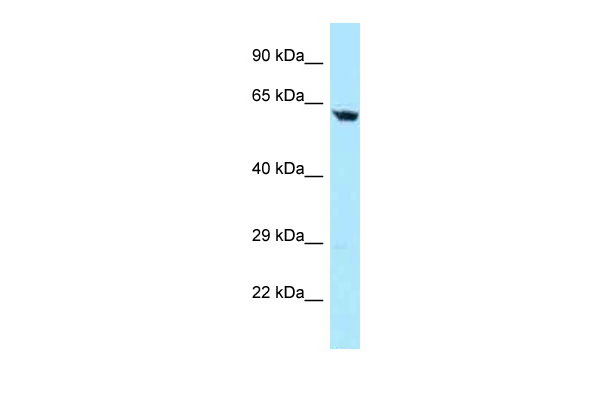TBRG4 antibody - N-terminal region
Rabbit Polyclonal Antibody
- SPECIFICATION
- CITATIONS
- PROTOCOLS
- BACKGROUND

Application
| WB |
|---|---|
| Primary Accession | Q969Z0 |
| Other Accession | NM_004749, NP_004740 |
| Reactivity | Human |
| Predicted | Human |
| Host | Rabbit |
| Clonality | Polyclonal |
| Calculated MW | 69kDa |
| Gene ID | 9238 |
|---|---|
| Alias Symbol | CPR2, FASTKD4, KIAA0948 |
| Other Names | Protein TBRG4, Cell cycle progression restoration protein 2, Cell cycle progression protein 2, FAST kinase domain-containing protein 4, Transforming growth factor beta regulator 4, TBRG4, CPR2, FASTKD4, KIAA0948 |
| Format | Liquid. Purified antibody supplied in 1x PBS buffer with 0.09% (w/v) sodium azide and 2% sucrose. |
| Reconstitution & Storage | Add 50 ul of distilled water. Final anti-TBRG4 antibody concentration is 1 mg/ml in PBS buffer with 2% sucrose. For longer periods of storage, store at 20°C. Avoid repeat freeze-thaw cycles. |
| Precautions | TBRG4 antibody - N-terminal region is for research use only and not for use in diagnostic or therapeutic procedures. |
| Name | TBRG4 (HGNC:17443) |
|---|---|
| Function | Plays a role in processing of mitochondrial RNA precursors and in stabilization of a subset of mature mitochondrial RNA species, such as MT-CO1, MT-CO2, MT-CYB, MT-CO3, MT-ND3, MT-ND5 and MT-ATP8/6. May play a role in cell cycle progression (PubMed:9383053). |
| Cellular Location | Mitochondrion matrix |
| Tissue Location | Ubiquitously expressed (PubMed:12759187). Expression detected in spleen, thymus, testis, ovary, colon, heart, smooth muscle, kidney, brain, lung, liver and white adipose tissue with highest expression in smooth muscle (PubMed:20869947) |

Thousands of laboratories across the world have published research that depended on the performance of antibodies from Abcepta to advance their research. Check out links to articles that cite our products in major peer-reviewed journals, organized by research category.
info@abcepta.com, and receive a free "I Love Antibodies" mug.
Provided below are standard protocols that you may find useful for product applications.
References
Nagase T.,et al.DNA Res. 6:63-70(1999).
Ohara O.,et al.Submitted (JAN-2004) to the EMBL/GenBank/DDBJ databases.
Suzuki Y.,et al.Submitted (APR-2005) to the EMBL/GenBank/DDBJ databases.
Bechtel S.,et al.BMC Genomics 8:399-399(2007).
Scherer S.W.,et al.Science 300:767-772(2003).
If you have used an Abcepta product and would like to share how it has performed, please click on the "Submit Review" button and provide the requested information. Our staff will examine and post your review and contact you if needed.
If you have any additional inquiries please email technical services at tech@abcepta.com.













 Foundational characteristics of cancer include proliferation, angiogenesis, migration, evasion of apoptosis, and cellular immortality. Find key markers for these cellular processes and antibodies to detect them.
Foundational characteristics of cancer include proliferation, angiogenesis, migration, evasion of apoptosis, and cellular immortality. Find key markers for these cellular processes and antibodies to detect them. The SUMOplot™ Analysis Program predicts and scores sumoylation sites in your protein. SUMOylation is a post-translational modification involved in various cellular processes, such as nuclear-cytosolic transport, transcriptional regulation, apoptosis, protein stability, response to stress, and progression through the cell cycle.
The SUMOplot™ Analysis Program predicts and scores sumoylation sites in your protein. SUMOylation is a post-translational modification involved in various cellular processes, such as nuclear-cytosolic transport, transcriptional regulation, apoptosis, protein stability, response to stress, and progression through the cell cycle. The Autophagy Receptor Motif Plotter predicts and scores autophagy receptor binding sites in your protein. Identifying proteins connected to this pathway is critical to understanding the role of autophagy in physiological as well as pathological processes such as development, differentiation, neurodegenerative diseases, stress, infection, and cancer.
The Autophagy Receptor Motif Plotter predicts and scores autophagy receptor binding sites in your protein. Identifying proteins connected to this pathway is critical to understanding the role of autophagy in physiological as well as pathological processes such as development, differentiation, neurodegenerative diseases, stress, infection, and cancer.


